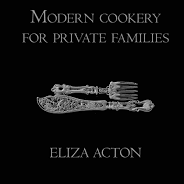Raspberry Jam Recipe: A Past Preserved
/Eliza Acton might not be a household name today, but anyone who’s ever followed a recipe owes her a debt of gratitude. Before she published Modern Cookery for Private Families in 1845, most recipes were written in vague, rambling prose, leaving home cooks to guess the quantities, timing, and techniques. Acton revolutionized that format by listing ingredients separately and offering step-by-step instructions. While not always exact by today’s standards, her structure became the model for the modern recipe.
Her book was a practical, beautifully written guide that brought clarity to home cooking. Though the more commercially savvy Isabella Mary Beeton, known as Mrs. Beeton, later overshadowed Acton’s influence, many of Beeton’s recipes were borrowed directly from her predecessor’s groundbreaking work.
Acton believed that good home cooking rested on clear instructions, careful technique, and fresh, high-quality ingredients. A perfect example of her approach is her recipe for raspberry jam—a staple in English households.
Here’s how the recipe appears in the 1882 edition of her book:
“This is a very favourite English preserve, and one of the most easily made that can be. The fruit for it should be ripe and perfectly sound... Bruise gently with the back of a wooden spoon, six pounds of ripe and freshly-gathered raspberries, and boil them over a brisk fire for twenty-five minutes; stir to them half their weight of good sugar, roughly powdered, and when it is dissolved, boil the preserve quickly for ten minutes, keeping it well stirred and skimmed.”
That’s six pounds of raspberries to three pounds of sugar—a lighter ratio than her earlier editions, but still quite sweet for modern tastes. Today, we have the benefit of refrigeration and smaller households, so this version retains the spirit of Acton’s recipe while scaling it down and reducing the sugar to suit modern kitchens.
Raspberry Jam (Modern Low-Sugar Version)
Inspired by Eliza Acton’s 1882 recipe in Modern Cookery for Private Families.
Photo: @hungry_eyes_dublin
Ingredients:
2 cups fresh raspberries (about 9 oz)
½ cup granulated sugar
Juice of ½ lemon (optional but helps with setting and brightness)
Instructions:
Sterilize jars: Wash in hot, soapy water and warm in a 250°F oven for 10 minutes.
Cook the fruit: In a medium saucepan, gently mash the raspberries with a wooden spoon. Bring to a simmer over medium heat and cook for 10 minutes, stirring often.
Add sugar: Stir in the sugar and lemon juice. Once the sugar has dissolved, boil the mixture rapidly for another 5–7 minutes. Stir often and skim off any foam.
Test the set: Drop a small spoonful onto a cold plate. If it wrinkles when pushed, it’s ready. If not, continue boiling for an additional two minutes.
Jar it: Pour the mixture into warm, sterilized jars and seal them tightly. Let cool before refrigerating. Use within a few weeks, or freeze for longer storage.
Sweet, vivid, and full of fresh summer flavor, this is the kind of preserve that still connects us to cooks of centuries past, when technique, patience, and fruit picked at its peak made all the difference.
Bright, fresh, and full of summer flavor, this is the kind of jam that reminds us how home cooks have been making the most of peak-season fruit for generations, with a little time and a lot of love.
Serving Suggestion (Wine Included!)
Here’s a simple idea: swirl a tablespoon of raspberry jam into a cup of soft goat cheese, and serve it with crackers and a glass of wine. A lightly chilled, low-alcohol wine, like a demi-sec Crémant rosé, Beaujolais, or Frappato, would be a good match for the jam’s tart-sweet kick. It’s an easy, no-fuss appetizer and a nice little tribute to Acton’s love of clear, simple cooking.







